The iPhone 5 Review
by Anand Lal Shimpi, Brian Klug & Vivek Gowri on October 16, 2012 11:33 AM EST- Posted in
- Smartphones
- Apple
- Mobile
- iPhone 5
Display: Now 16:9 with full sRGB Coverage
Section by Brian Klug
A huge part of the story of what’s new in the iPhone 5 is obviously the display. At a high level what’s different is pretty simple sounding: aspect ratio is now 16:9, resolution is 1136 x 640, gamut coverage is now almost exactly sRGB, and the digitizer is now in-cell as opposed to on-cell. Let’s go through those changes.
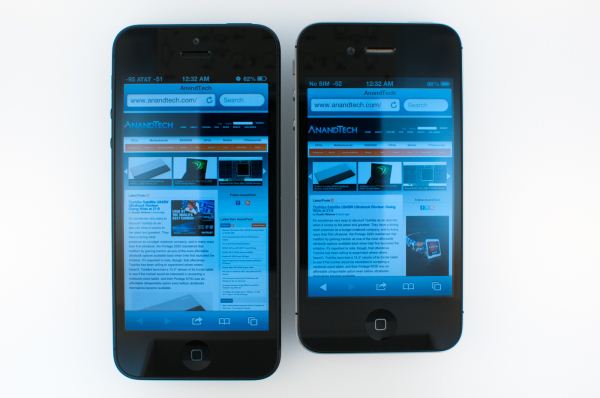
iPhone 5 (left), iPhone 4S (right)
Since the original iPhone days, aspect ratio for the phone has been an immutable 3:2, and later on the iPad adopted an aspect ratio of 4:3. All the while, the aspect ratio wars for content and media have been warring, and by now it’s obvious that 16:9 has won. YouTube changed over to 16:9 just a year after the original iPhone launch, and since then other sources of content have moved that way as well. We saw 16:9 take over as the dominant HD format, and like it or not the same has played out on the PC with a march from 4:3 to 16:10 to 16:9. The move to 16:9 for the iPhone now enables most modern video content to play back without (or with very little) letterboxing, and simultaneously expands the viewport a considerable amount for other applications. A huge number of iOS applications are essentially a list view or a tabbed view with a list down below, and thus are immediately suited in portrait rotation to take advantage of more vertical space. I spend most of my time in portrait mode with rotation locked on iOS, and increasingly it seems as though landscape rotation is a marginalized view for application developers, so this seems to be a sound path forward.
The route Apple chose to get the iPhone to 16:9 is now widely known. They kept width the same at 640 pixels and roughly 5 cm, and instead opted to make the display taller, at 1136 pixels and roughly 8.85 cm, up from 960 pixels and 7.39 cm on the iPhone 4/4S. Interestingly enough 1136 isn’t exactly 16:9, a closer target would be 1137, but we’re talking about one or two pixels that simply get cropped out on video decode and display for most media.
I’ve talked about how Android is now an almost entirely 16:9 camp, and that really frames my thoughts about the iPhone 5’s display size change. In the past, switching back and forth between iOS which was 3:2 previously and modern Android handsets that were 16:9 never felt very extreme. There was a noticeable difference in overall size, sure, but aspect ratio never quite made that big of an impression on me considering the differences in OS. After spending a lot of time with the iPhone 5’s 4-inch, 16:9 display, switching back to the original iPhone format’s 3.5-inch, 3:2 display is a downright jarring experience. It’s readily apparent just how much the platform needed this change in both aspect ratio and size, if nothing else to compete with increasingly larger and larger consumer expectations for display size. It’s interesting as well how discussion about thumb radius sweeping a semicircle out from the bottom corners of the display also quieted down with the change. We’ve talked in the past about how the typical smartphone grip isn’t really centered around the bottom but rather shifted up slightly. I don’t find that the iPhone 5’s larger display changes or diminishes one-handed use significantly at all.
Apple has of course made changes to iOS to accommodate the change in aspect ratio, and those first party applications take advantage of the 176 extra vertical pixels. For starters, the landscape keyboard gets wider keys but doesn’t quite fill up the whole 1136 wide canvas. There’s also another row for applications on homescreens, and another row inside folders.
For third party applications however that road to 16:9 for the iPhone 5 and newest iPod Touch display requires some tweaking, and a trip through the App Store approval process, otherwise you end up with letterboxing. There’s really nothing else that Apple could’ve done besides letterboxing to accommodate older apps that either aren’t updated or will never be updated, but the downside of this centered letterboxed experience is that it shifts portrait apps and the keyboard up by 88 pixels.
A great example of where this is jarring is the IM application I use, imo.im, which hasn’t been updated as of this writing to take advantage of the new viewport size. As a result, typing on this 88-pixel-shifted keyboard requires repositioning one’s grip. This is a temporary grievance though that will go away in time as developers update things, but still warrants mentioning. It’s similar to but not identical to the same kind of friction we saw with the path to retina-enabled apps with the iPhone 4 launch.
In-Cell
The next major improvement is in-cell touch. The iPhone 5 isn’t the first smartphone to include an in-cell touch LCD, but perhaps the first where we’ve seen lots of talk about it. Part of getting to even thinner form factors is either eliminating or reducing the thickness of everything in the z direction. In addition, increasing the light throughput of the display stack (which means both filters and everything between the backlight LEDs and your eye) is a huge driver for overall battery life, since the display is still by far the largest consumer of precious milliwatts in a smartphone.
One of those things is the digitizer, which previously sat on top of the LCD as a separate layer incurring both additional thickness and back reflections. While successive generations of both iPhone display stacks (and the smartphone platform in general) have eliminated a lot of back reflections by reducing the number of air-glass interfaces with optical-grade adhesive lamination (and thus 4 percent Fresnel reflections that go along with each of them), ultimately these glass-adhesive interfaces still incur some path loss and still have a z profile. The only way to reduce these further is to go to in-cell touch, which really is a fancy way of saying that the digitizer is then integrated into the LCD-TFT gating itself, and thus into the cells of each pixel, rather than as a discrete layer atop the stack after color filters.
Getting to this level of integration requires cooperation between both the display driver and touch sensor, and herein lies the challenging engineering problem that in-cell touch poses. Touch sensing has to be time multiplexed with display driving otherwise the touch signal might be entirely lost in noise. At the same time, touch sensing is often around double the frequency (120–175 Hz) of display drawing (60 Hz), so this has to be done carefully during quiet periods, and thus that required communication and integration. The iPhone 5 uses a combination of TI and Broadcom controllers to do display controller and touch sensing, where previous generations of iPhone simply just used a single chip TI solution. In future generations this will come back down to just being a single-chip solution.
Subjectively thus far I haven’t detected any change in tracking quality or performance with the iPhone 5’s in-cell solution, which is great. To end users the difference seems to be totally transparent.
In addition to just the air-adhesive interfaces introducing thickness and unavoidable Fresnel reflections, there’s also the traces from transparent conductors in the digitizer as well to think about. At present that material is Indium Tin Oxide (ITO), which is one of very few known transparent conductors and used inside every LCD. Because Indium is a relatively expensive rare earth metal, ITO traces are only laid down where they need to be on top of and below the glass substrate (for both transmit and receive layers of the digitizer), and the areas inbetween those traces are then filled with an index-matching space fill material to diminish their visibility. How well this space fill is done and how close the index is to ITO’s is one of the quality metrics of a digitizer to begin with, and often these rows and columns are visible under direct illumination either outdoors or with good eyes indoors. Often you can tell a lot about how much value an OEM placed on its entire digitizer just by how distracting these are outdoors, but the big benefit with in-cell is that they go away entirely, which is a huge gain I rarely see people talking about in the context of in-cell improvements.
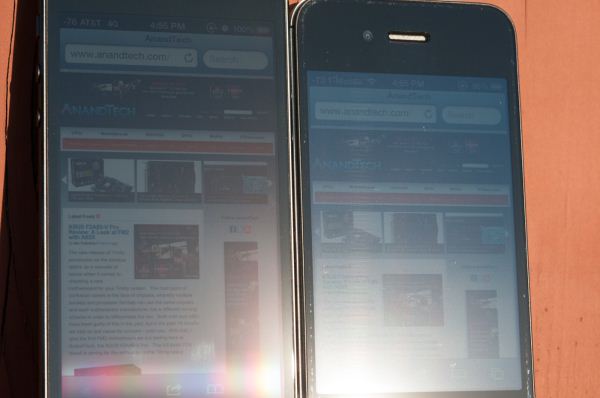
Horizontal lines on the iPhone 4S (right) from the digitizer (easier to see at full size)
That change leads to what I would consider a huge improvement in outdoor visibility, since these lines are now totally gone on the iPhone 5. In addition, there’s no longer a contrast-diminishing set of back reflections from the extra glass layer when outdoors. This is very visible in the photos I’ve taken showing outdoor viewing behavior on both the iPhone 4S and iPhone 5.

Significantly less blue haze on the iPhone 5 (left) than iPhone 4S (right)
Display Quality
Our own Chris Heinonen already did an excellent job characterizing the iPhone 5 display using our new CalMAN 5 based test suite he put together, and I’d encourage everyone to read that for a much more comprehensive version of an iPhone 5 display analysis. There’s really not a whole lot for me to add other than some results from the two other main smartphone displays I’ve tested with this new workflow, and some graphs with data from other phones. Chris has better instrumentation than I do with an i1Pro, but we’ve tweaked the workflow slightly so I ran the iPhone 5 and 4S through the test. In addition Apple has multiple suppliers for the iPhone 5 display so there are bound to be some differences in devices.
Subpixel geometry and size is still the same on the iPhone 5, meaning this is still a “retina” display and all the usual discussion about angular subtense and visual acuity still applies. You can see this under the microscope (all these images are at the same magnification, focus is a bit different though given the different optical path length thanks to that in-cell touch) — both the geometry and pixel pitch are unchanged between the 4S and 5.

To start are our brightness and contrast graphs which are measured at 100 percent brightness. The iPhone is even brighter than the iPhone 4 and 4S displays, at just over 600 nits on my unit. I saw some variance back between the iPhone 4 and 4S in brightness, so depending on where you’re coming from this can be a noticeable jump. Apple started off with good consistency when the iPhone 4 came out, but I saw lots of white point and luminance variance with that form factor display as time progressed and we moved from the 4 GSM to 4 CDMA to 4S.
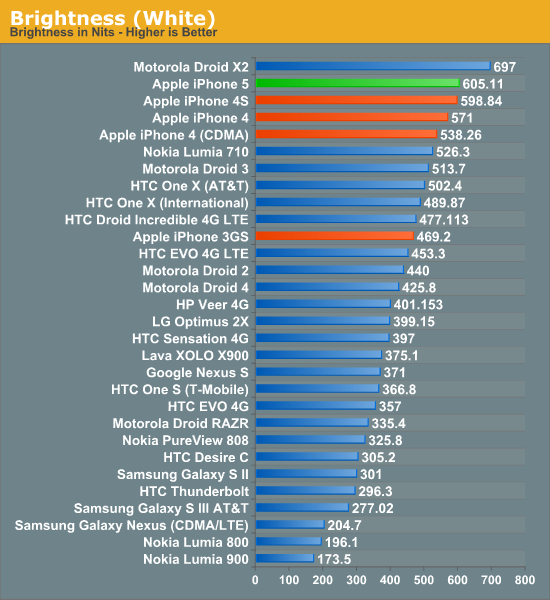
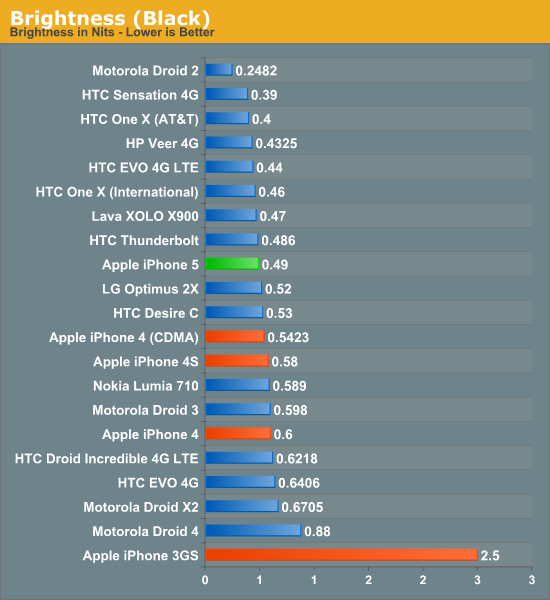
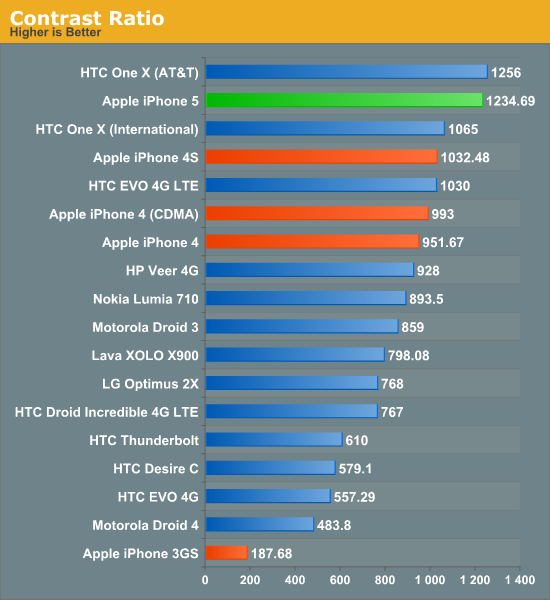
When it comes to gamut, Apple announced that the iPhone 5 display has full sRGB coverage. The iPad 3 was actually first in Apple’s lineup to advertise roughly full sRGB coverage, but it appears that the iPhone 5 is even closer to being spot on. Using our new CalMAN workflow we can easily measure and compare the overall saturations for primaries and secondaries, the ideal values of which are represented by white boxes. There’s a whole lot of measuring required for each phone, so I pared it down to just the iPhone 5, 4S, HTC One X, and Galaxy S 3 for the moment.
Saturations and Gamut
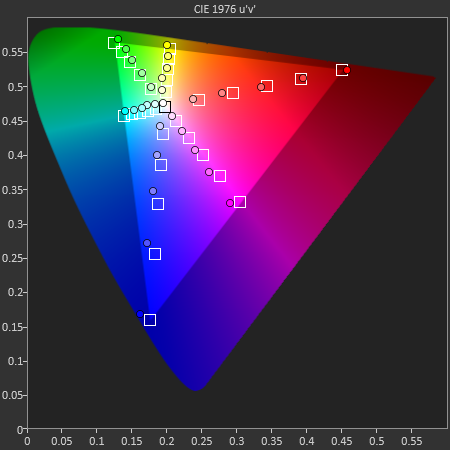
The iPhone 5 is, like Chris said already, the closest smartphone I’ve seen to sRGB to date. It’s really clear to me that Apple puts a strong emphasis on its suppliers to both deliver a display capable of hitting that gamut, and then bothers to do some factory level calibration to get reasonably close. I’ve seen this drift over time but for the time being the iPhone 5 is quite close to being ideal all things considered.
The GretagMacbeth ColorChecker card test colors are next up, and it isn’t surprising here to see some variance, but the values from the iPhone 5 are very close to the intended colors compared to the competition and its predecessor.
GMB Color Checker
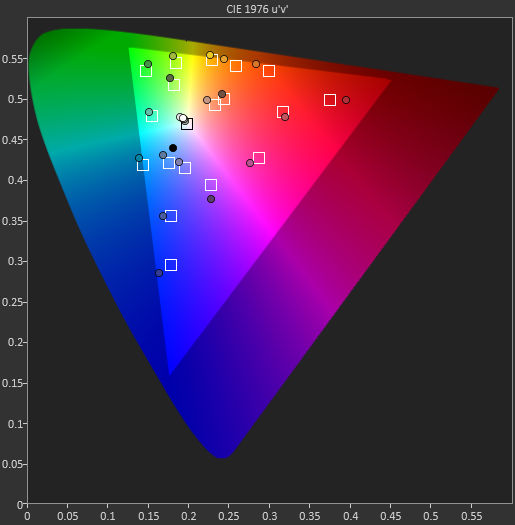
Grayscale and gamma represents our steps of 5 percent grey from 0 to 100 and we get a report for contrast, the white and black levels, color temperature, gamma, and average Delta E 2000 here.
Grayscale and Gamma
My values differ from Chris’ slightly, but my instrumentation and phone are both different from his which may explain some of the differences. The high level story is the same though, the iPhone 5 tracks closer to the ideal than any of the other devices. I’ve also gone ahead and made a table with the average Delta E from each step.
| CalMAN Display Comparison | |||||||
| Metric | iPhone 5 | iPhone 4S | HTC One X | Samsung Galaxy S 3 | |||
| Grayscale 200nits Avg dE2000 | 3.564 | 6.162 | 6.609 | 4.578 | |||
| CCT Avg (K) | 6925 | 7171 | 5944 | 6809 | |||
| Saturation Sweep Avg dE2000 | 3.591 | 8.787 | 5.066 | 5.460 | |||
| GMB ColorChecker Avg dE2000 | 4.747 | 6.328 | 6.963 | 7.322 | |||
Last up is the indoor viewing angles comparison between the iPhone 5 and the 4S, which are essentially unchanged. Even at extreme angles I can’t detect any major differences in viewing angle between the 4S and the 5, which is a good thing since there isn’t really anything to complain about.



















276 Comments
View All Comments
themossie - Tuesday, October 16, 2012 - link
The manufacturer's charger uses a set of pull-up resistors connected between the various USB lines, to indicate that the phone can pull maximum current. Unfortunately, every manufacturer (and sometimes different phones) use different resistances.See http://electronics.stackexchange.com/questions/144... for a brief writeup.
For what it's worth, I've only had this problem with iDevices and the HP Touchpad. I own circa-2011+ HTC, Motorola and Samsung phones, and they all work fine with every charger. My Droid 2 Global was my primary work phone until a few months ago, and works great with every charger. Not sure why your wife is having problems there.
crankerchick - Tuesday, October 16, 2012 - link
"The non-LTE phones see a sharp drop in battery life. At least at 28nm the slower air interfaces simply have to remain active (and drawing power) for longer, which results in measurably worse battery life. Again, the thing to be careful of here is there's usually a correlation between network speed and how aggressive you use the device. With a workload that scaled with network speed you might see closer numbers between 3G and 4G LTE."Perhaps you all could devise a test for this? Something like, change your LTE and 3G tests, where you decrease the time between page loads for the LTE test, to simulate doing more browsing since the pages load faster? One data point on this, with a reasonably selected change in page load duration, would be very helpful now that we have this very interesting dynamic clearly visible.
That said, as always, I appreciate the reviews presented here. Always thorough with lots of information to chew on beyond specs and "user opinion on user experience."
Just wish the reviews didn't take so long, but they are always worth it in the end.
TofDriver - Tuesday, October 16, 2012 - link
Thanks for this awesome article. Gigantic work, we'll worth the wait.I've learnt so much.
Would still appreciate it as an ebook, even after the web reading!
Seems like you're perfectionists who love to push limits... To me it does resonate with the team who designed the reviewed product.
name99 - Tuesday, October 16, 2012 - link
"Another potential explanation is that the 3-wide front end allowed for better utilization of the existing two ALUs, although it's also unlikely that we see better than perfect scaling simply due to the addition of an extra decoder."Remember the standard numbers. On this type of integer code:
1/6 instructions are branch
1/6 instructions are store
1/3 instructions are load
1/3 instructions are ALU
This means the usual first throttling point i cache access, if you can only do one load/store cycle.
If you limit your cache to one op/cycle, it's generally not worth going beyond 2-wide --- too often you're waiting on the cache.
Once you widen your cache (usually, at this stage, by allowing simultaneous read and write per cycle) three-wide makes sense.
Each cycle now (on ideal and some sort of "average" idealized code) you can now do some sort of combination of half a branch, 1.5 load/stores, and 1 ALU. Meaning that 2 ALUs (as long as they are not overloaded and also handling some aspect of the load/store) is enough for now.
[Of course things never work out quite this ideal --- you have burstiness in operation types, not to mention delays. But the compiler should try to schedule instructions to get this sort of average, and likewise the re-order queues will do what they can to shuffle things to this sort of average. 2ALUs helps with the bursts, 3ALUs is overkill.]
So I would say the primary important change made to go to three-wide in a way that is not a waste of time was to convert the L1 cache to dual-ported, supporting simultaneous load & store per cycle.
jiffylube1024 - Tuesday, October 16, 2012 - link
I have to commend the Anandtech team for the great review! It was a long wait, but well worth it. The info on anodizing, the "Swift" CPU @ 1.3 GHz, camera performance, etc. was worth waiting for. This article, in my eyes, is a culmination of the Anandtech team's knowledge in the tech industry - deconstructing A6 to figure out what it's made of, discussing Apple's manufacturing capabilities, etc. Very informative and well written!I am always amazed at how many complaints (and petty platform wars) get exposed on the comment board. I certainly appreciate them when an article is poorly written, contains false information or outright lies, but with an article like this, the comments section seems shy of the effusive praise it deserves!
------
On a slight tangent, I've enjoyed the first 8 Anandtech podcasts as well, and I have to say that I look forward to more non-iPhone related disucssion on future podcasts. The information was much appreciated, but for a tech site as broad as Anandtech, the first 8 podcasts have been VERY iPhone heavy in their content! Keep up the good work.
jamyryals - Thursday, October 18, 2012 - link
I think you're right, it has been iPhone heavy, but the start of the podcast kind of lined up with the launch/review process. Let's be honest, it is a huge selling high quality device and it's treated as such. I have a feeling Brian and Anand will have a lot to say about all of the impending Nexii/WP8 when they come out this quarter.krumme - Tuesday, October 16, 2012 - link
Good to see reviewers apreciation of low light capabilities for the BSI sensor, reflecting real world usage. Oposite to a lot of uninformed stupid reviews on the net.Its exactly the same practical difference between s2 and s3 cameras. Big difference for real usage.
All the mpix race must stop now. 8M is way to much for the quality anyway.
Zanegray - Tuesday, October 16, 2012 - link
I love the level of analysis and attention to detail. Keep it up!mrdude - Tuesday, October 16, 2012 - link
Wow, what an article. Really fantastic read. The lengths you guys have gone to in this review is stunning, frankly. Well done. Although I'm no Apple fanatic, I must say that this is one of the better articles I've read on AT :)Dennis Travis - Tuesday, October 16, 2012 - link
Totally outstanding review. You guys covered everything. Thanks so much!